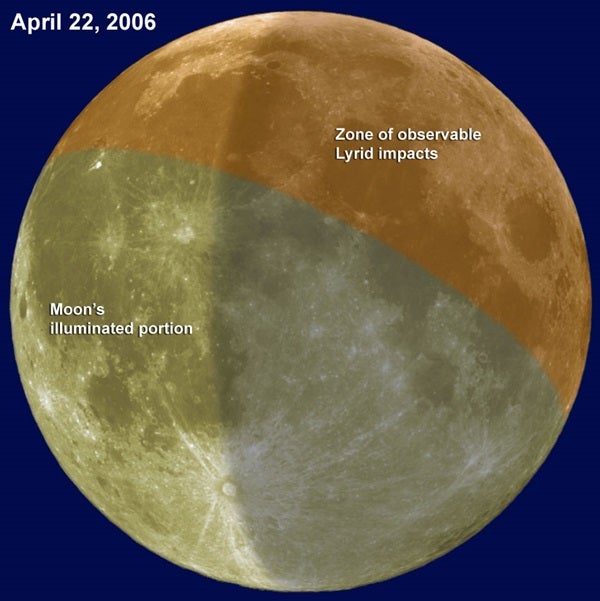The Lyrid meteor shower reaches its peak Saturday morning in a moonless sky — great circumstances for watching the shower’s faint, fleeting meteor trails. The waning crescent Moon stays below the horizon until about 3 a.m. for observers at mid-northern latitudes. This gives skywatchers several hours of dark sky late Friday and early Saturday in which to enjoy the show.
This year, though, moonrise brings an opportunity to witness something unusual. Those with a modest telescope — and a lot of patience — may witness point flashes from Lyrid meteoroids striking the lunar surface.
“Lunar impacts are petty rare events,” says Brian Cudnik, who coordinates amateur observations of lunar impacts for the Association of Lunar and Planetary Observers. As many as a dozen members may be watching the Moon for impacts during any observing opportunity, he says. “There are between 5 and 8 favorable alignments each year” in which the Moon’s unilluminated side grazes a stream of meteoroids. “Most of the time it’s an evening event, involving a waxing crescent, but in this case it happens in the morning with a waning crescent,” he explains.
Lyrid particles, which are shed by Comet Thatcher (C/1861 G1), collide with Earth or Moon at a brisk 108,000 mph (173,800 km/h). Meteors are brief glowing trails produced as comet material burns up in Earth’s atmosphere. The same particles can strike the Moon’s surface, creating a brief pinpoint flash as bright as magnitude 7 — easily within the range of small scopes.
“The Lyrid shower is rather weak, so the chances of seeing a lunar impact are slim, but there’s always that chance,” Cudnik says. Impacts have been reported during the Leonid, Perseid, and Taurid showers. Low-light-level video cameras offer the best way to identify a hit, but determined visual observers can see lunar strikes, too.
| Fast facts: Lyrid meteor shower |
|
|
|
|
|
|
|
|
|
|
|
|
|
|
Cudnik suggests the minimum equipment needed is a telescope with a 2.4-inch (60mm) aperture, a short-wave radio tuned to the time signals from WWV, and a handheld tape recorder. The tape recorder will pick up both the time signals and the observer’s call of possible impacts, important for comparing reports.
“Put the bright part of the Moon out of the field of view, and watch for point flashes,” Cudnik explains. He recommends visual observers work in brief, 15-minute sessions between 5- or 10-minute breaks. “Go ahead and give it a try,” he says. “The only other ingredient is lots of patience.”
Amateurs won’t be the only ones looking. According to Bill Cooke of NASA’s Marshall Space Flight Center in Huntsville, Alabama, his space-environment group will be monitoring the Moon using low-light-level video from two telescopes: a 10-inch (25.4 centimeter) Newtonian and an 8-inch (20.3 cm) Schmidt-Cassegrain. “It’ll be a short and sweet observation,” he says, because interference from twilight will begin about 2 hours after moonrise from Huntsville. Last November, using similar equipment, Cooke’s group detected a possible lunar impact as the weak Taurid meteor shower reached its peak.
If you miss this chance to watch either meteors or lunar impacts, Cudnik says, two additional opportunities are just around the corner. On May 6, when the Eta Aquarid meteor shower peaks, a waxing gibbous Moon rises about a few hours after sunset. The entire unlit portion of the Moon could be hit by tidbits from Halley’s Comet.
Cudnik hopes another May event, the close approach of fractured Comet 73P/Schwassmann-Wachman 3 on May 24, may produce impacts, too. “The comet is broken into at least 31 fragments,” Cudnik says. “If there’s a wider swath of smaller debris around them, the particles could produce meteors for Earth and impacts for the Moon.”










